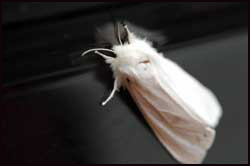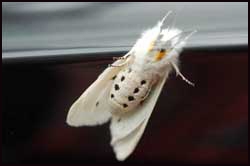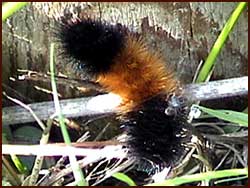Butterflies, Moths & Skippers

Differences Between Butterflies, Moths & Skippers
Butterflies typically fly during the day, rest with their wings erect, have well-defined club-like antennae, have slender bodies with bright colors. The butterfly caterpillar creates a chrysalis to transform into an adult.
Moths are active at night, rest with their wings flat, have feathery antennae, have robust bodies with drab, cryptic colors. The moth caterpillar spins a cocoon as their vehicle of transformation to adults.
Skippers are neither butterflies nor moths. They hold the hind wing flat and the forewing erect along with a semi-club antennae. A great article, Bug of the Month: August 1995 Woodland Skipper Butterfly by Louise Kulzer, has some very interesting information about this unique Lepidoptera.
Butterflies Taste with Their Feet
Butterfly larsi or feet possess a sense similar to taste. When there is contact with sweet liquids such as nectar, it causes the tongue to uncoil. Their feet are so sensitive, they can tell the difference between related plant species. Read Diane Greening's very interesting article, National Wildlife Federation / San Diego County Butterfly Basics for more information about these sensitive larsi.
Butterflies Prefer Pizza
Butterflies don't really like pizza, but they do like flowers that have flat heads like pizza. The best nectar choice is to choose native plants with flat or clustered heads or ones with short tubes so they can reach the nectar with their tongues.
Plant Host Plants for Butterflies
It's also very important to plant host plants or larval plants. These plants are necessary for the caterpillars. Butterflies and Their Larval Foodplants has a chart listing the butterfly along with their specific food plants.
Puddling & Basking Butterflies
Males often congregate around shallow mud puddles. Here, they drink and extract salts and minerals. If a puddling area isn't available in your backyard, try to create a mini-mud spa area for them.
Because butterflies are cold-blooded, they love warm sunny areas. They are particularly fond on lying on warm flat rocks or stones to bask in the sunshine. Create a butterfly basking area where it's protected from strong winds.
Oregon Silverspot Butterfly - A Threatened Species
This brown and orange butterfly living in the humid coastal salt-spray meadows and fields is considered a threatened species. According to Enchanted Learning, the Oregon Silverspot Butterfly is threatened due to a loss of habitat and the decline of its host plant, the Early Blue Violet (Viola adunca).
Butterfly Field Guides
My thanks to Terry Morse for his field guide suggestions below; his help in identifying Woodland Skippers; and for making me think when he said ... if you like moths, and not enough people do ...
The guides that he highly recommended are listed below. All butterfly guides can be purchased from NABA (North American Butterfly Association) or other book stores.
- National Audubon Society Field Guide to Butterflies of North America
- Western Butterflies by Paul Opler
- Butterflies of Cascadia by Robert Michael Pyle
- Butterflies Through Binoculars: The West, by Jeffrey Glassberg
Oregon Butterfly Web Sites
For help in identification of Oregon butterflies, check out the following web sites:
- Oregon Butterflies
- Butterflies & Moths of North America (Click on State and County in Map Search)
Moths
Yellow Woollybear Tiger Moth (Spilosoma virginica)


The above images of the Yellow Woollybear Tiger Moth were taken on July 3, 2006. Notice the orange-yellow femur on the forelegs along with the black spots on the underside of the moth. These moths eat a variety of plants and can be considered a garden pest.
Woollybear Caterpillar (Isia isabella)

This common caterpillar has long setae (bristles) that can irritate a person's skin. They have little suction pads on their feet which allow them to hang on trees and branches. Eventually the caterpillar turns into an orange moth with cream-colored wings and black spots referred to as an Isabella Moth.
A notion maintained despite evidence to the contrary is that can you tell whether the winter is going to be mild or rough by looking at the size of the narrow red band. If this band is narrow, it indicates a rough winter; and if the band is wide, it indicates a mild winter. In truth, the red band in the mid-section decreases with age as the black bands increase thus telling us how close the caterpillar is to being fully grown before it seeks winter shelter. The above image of the woollybear caterpillar was taken on October 16, 2005.
More Moth Images
If you are interested in moths, Web Images of North American Moth Species has over 4,100 images of moth species. Also, the Bug Guide is an extremely valuable source for images of moths along with all other bugs. If you can't identify an image, you can post the image to obtain help with identification.
Moth Field Guides
When you click on either of the following two publications, you will go the USGS site. There, you can read the publication, download the publication or request a printed version.
- Macromoths of Northwest Forests and Woodlands (#FHTET-98-18)
- Caterpillars of Pacific Northwest Forests and Woodlands (#FHM-NC-06-95)
To order a free copy of publication #FHTET-2003-03, Lepidoptera of the Pacific Northwest: Caterpillars and Adults, contact Richard Reardon at rreardon@fs.fed.us.
